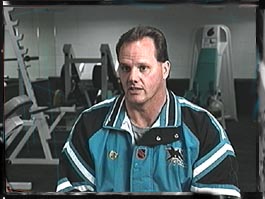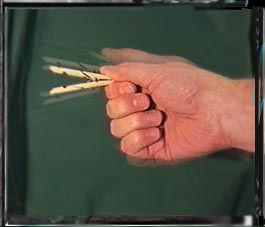|

|
Steve Millard discusses why players ride stationary
bikes at the end of a game.
|
|
Coming down
After one of the most intense workouts in team sports,
what you do when the game is over? The answer was surprising. Most of the
players will hop on a stationary bicycle and ride for a half hour. Why do
players do this? We asked Steve Millard. He said the players ride the bicycles
to help remove lactic acid from their systems. Lactic acid is what causes
muscles to burn after strenuous exercise. To really understand why riding
a bicycle after playing a hockey game makes sense, let's look closer at
lactic acid.
|
|
Lactic acid forms as a by-product of energy production by
the muscles. Muscle fibers convert glycogen (which is formed from glucose)
to
adenosine triphosphate
or ATP. ATP is the energy source muscle fibers use to make muscles contract. Some of the reactions in converting glycogen to ATP take place without oxygen, and when this happens a compound called
pyruvate
is produced. Some of this pyruvate can be converted into energy, but the excess becomes lactic
acid. The Exploratorium's new book,
The Sporting Life
, describes
lactic acid as, "a dead end as far as energy production is concerned."
So how do players (and the rest of us) relieve the soreness and turn around
this "dead end" situation? The best way is to continue to excercise,
but at a slower pace, without muscle strain. Also, if you can get it, a
good massage will help. Increasing blood circulation cleans out built-up
lactic acid from the muscles.
|
|
|
Clothespin Workout
(modified
from the book
The
Sporting Life
)
Now, we know that compared to a minute
of ice time in an NHL game, this clothespin activity may seem like a "wimpy"
workout-- but it does demonstrate how your muscles work. Also, you might
be surprised to find that you get tired out pretty quickly!
To get started, get a watch with a second hand. Now take an ordinary clothespin
(the spring-loaded kind) and hold it between your thumb and index finger.
See how many times you can open and close
the clothespin in one minute.
When your minute is up, DON'T STOP. See
how many times you can open and close it during a second full minute.
|

|
You may be surprised at the results of this "wimpy" workout.
|
|
What's going on?
Odds are you slowed down significantly
during your second minute. What are you, some kind of weakling who can't
twitch your fingers for two minutes without getting tired? Nope, it's just
a question of how your muscles get the energy they need to function.
When you were opening and closing the clothespin,
your muscles were exercising anaerobically, drawing on their stores of glycogen
to produce the ATP molecules that supply the energy they needed to contract.
As the glycogen ran out, your muscles ran low on ATP and their ability to
contract decreased.
If you squeeze the clothespin slowly, you're
exercising aerobically. In aerobic exercise, your muscles also draw on oxygen
and the glucose and fatty acids carried in by the blood to produce ATP.
Your ability to keep exercising aerobically depends on the delivery of oxygen
and fuel molecules (glucose and fatty acids) to your muscles. And that depends
on your circulation and respiration.
|
|
Click the "forward"
button below to continue.
|

©
Exploratorium
|